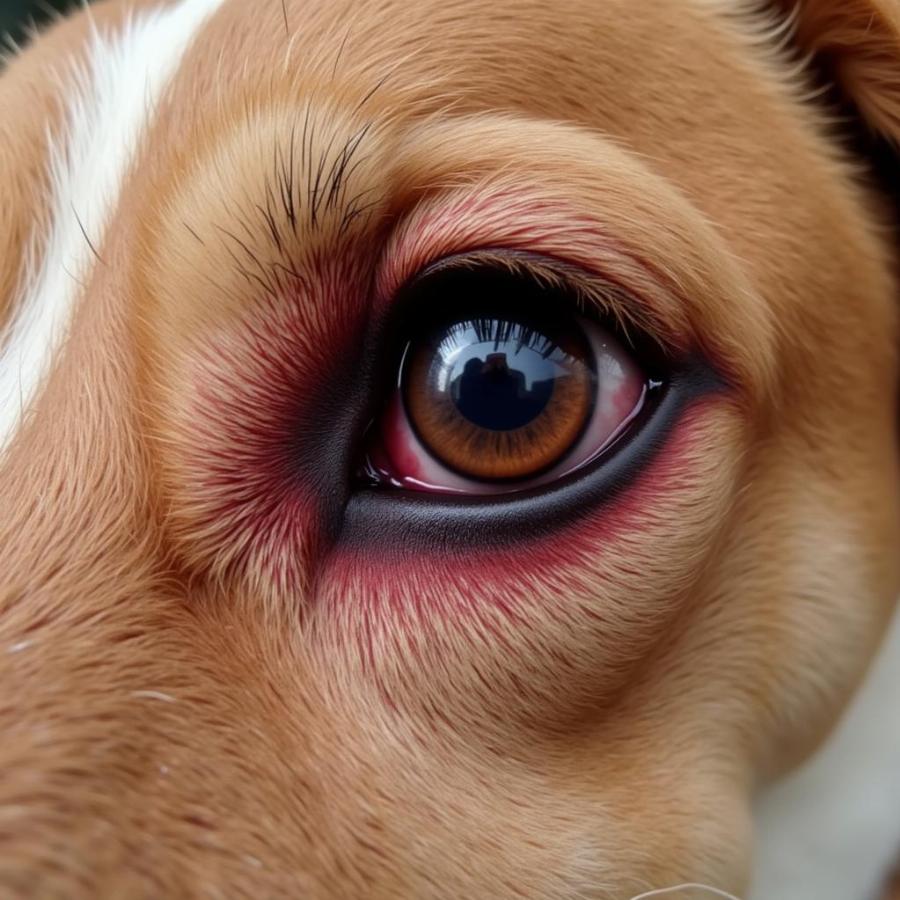Understanding eye problems in dogs can be challenging, especially when you’re unsure what to look for. Photos of eye problems in dogs can be a valuable tool for pet owners to identify potential issues and seek timely veterinary care. This article will delve into common canine eye problems, showcasing visual examples and providing guidance on when to consult a veterinarian.
Recognizing Common Canine Eye Problems Through Photos
From minor irritations to severe infections, dogs can experience a wide range of eye issues. Learning to identify the visual signs of these problems is crucial for early diagnosis and treatment. We’ll explore common eye problems like conjunctivitis, cataracts, glaucoma, and cherry eye, illustrating each with helpful photos. These photos of eye problems in dogs will help you differentiate between normal eye variations and potential health concerns.
Conjunctivitis, often called pink eye, is a common inflammation of the conjunctiva, the membrane lining the eyelids and covering the white part of the eye.
Understanding Conjunctivitis in Dogs
Conjunctivitis can be caused by allergies, irritants, infections, or underlying medical conditions. Photos of dogs with conjunctivitis often show redness, swelling, and discharge from the eye.
 Inflamed Conjunctiva in a Canine
Inflamed Conjunctiva in a Canine
If you notice these signs, it’s crucial to consult your veterinarian to determine the cause and appropriate treatment.
Cataracts: A Clouding of the Lens
Cataracts, a clouding of the eye’s lens, can impair vision and even lead to blindness if left untreated. Recognizing cataracts early is essential for preserving your dog’s sight.
Identifying Cataracts in Your Dog
Photos of eye problems in dogs showcasing cataracts typically reveal a milky or opaque appearance in the pupil. This cloudiness can range from subtle to pronounced, depending on the severity of the cataract.
different kinds of dachshund dogs often experience eye issues. Learning to recognize these signs is especially important for owners of this breed.
Glaucoma: A Serious Threat to Canine Vision
Glaucoma, characterized by increased pressure within the eye, is a painful condition that can lead to irreversible vision loss.
Recognizing the Signs of Glaucoma
Photos of eye problems in dogs depicting glaucoma often show a red, painful eye, sometimes accompanied by cloudiness, a dilated pupil, and squinting. If your dog exhibits these symptoms, seek immediate veterinary attention.
Cherry Eye: A Prolapsed Gland
Cherry eye, the prolapse of the third eyelid gland, is a common problem in certain dog breeds. While not typically painful, it can lead to irritation and dryness.
Identifying Cherry Eye in Dogs
Photos of dogs with cherry eye reveal a small, pink mass protruding from the corner of the eye, resembling a cherry. Surgical correction is usually recommended to restore the gland to its normal position.
puppy dog eyes meme While cute in memes, actual eye problems are serious.
When to Consult a Veterinarian
Any changes in your dog’s eyes, including redness, discharge, cloudiness, or squinting, warrant a veterinary examination. Early diagnosis and treatment are crucial for preventing serious complications and preserving your dog’s vision. dog papilloma photos While not an eye problem, these too need veterinary attention.
Conclusion
Photos of eye problems in dogs are a valuable tool for pet owners. By learning to recognize the visual signs of common eye conditions, you can take proactive steps to ensure your furry friend receives the necessary care. Don’t hesitate to contact your veterinarian if you have any concerns about your dog’s eye health. dogs with yellow eyes This is another area where a vet can determine if it’s normal or a problem.
FAQ
- What are the most common eye problems in dogs?
- How can I tell if my dog has an eye infection?
- Are cataracts in dogs treatable?
- What causes glaucoma in dogs?
- Is cherry eye a serious condition?
- How can I prevent eye problems in my dog?
- What are the signs of an eye emergency in a dog?